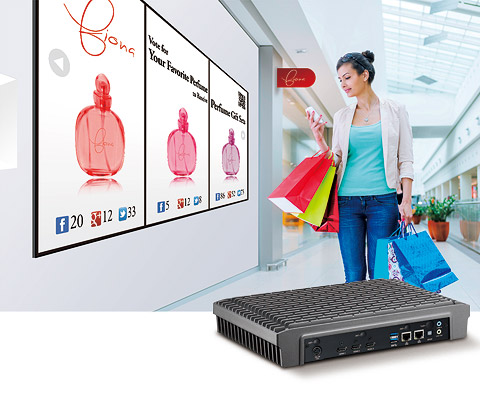Intelligent and Interactive Digital Signage Spurs Retail Sales Boom

In the past, digital signage only provided one-way information playback. As technological development and Internet of Things (IoT) have advanced the graphics and sensing technology, digital signage are moving towards intelligent and interactive applications, bringing unlimited business opportunities for the retail and related industries.
Digital signage applications emphasize dynamic playback ability. Under the influence of intelligent and interactive technologies, digital signage are moving to a turning point where it can help businesses to provide targeted advertisements and entertaining interactions to engage customers, allowing customers to learn more about the products through intelligent interactions, stimulating their interest, shopping experience, and purchase intent, and ultimately increasing sales.
Intelligent + Interaction: The Key Elements for Digital Signage Applications
Steven Wu, General Manager of NEXCOM's Vertical Industry Platform (VIP) division, states, "The continuous advancements in digital signage technology have ended the days of electronic posters and introduced a new generation of intelligent and interactive applications. These intelligent digital signage can integrate anonymous video analytics (AVA) to provide personalized viewing content. For example, Japan has deployed beverage vending machines with digital signage that can display product recommendations based on the consumers' age and gender, as well as the current weather conditions. This was a trial run which delivered impressive preliminary results. Sales more than tripled when compared to using traditional vending machines."
"An intelligent digital signage can also connect to the sales and inventory system and automatically adjust its content based on current stock levels, displaying special promotions for overstocked items to help reduce inventory. Not only this can stimulate sales, it can also serve as a tool for market analysis. For example, it can track view counts and dwell time of a particular advertisement, enabling owners to analyze traffic flow and customer demographics to measure the effectiveness of an advertisement. Businesses can also use this information to establish a clear basis for billing advertisers," Wu explains.
In recent years, touch and gesture-based controls have become the standard for user interaction and helped digital signage deliver interesting applications including virtual fitting rooms and virtual gaming. In addition, interactive digital signage can integrate mobile and social media, such as text message voting and Facebook video sharing to increase exposure, popularity and view counts, creating opportunities for viral marketing. Promotional content can also be sent to customers' mobile device through Bluetooth for real-time proximity marketing, turning the digital signage from passive to active displays.
Digital Signage Players: The Key Foundation for Intelligent and Interactive Applications
Digital signage players are the key components behind intelligent and interactive digital signage displays. Thus, they need to provide accurate and real-time image analysis, interactive technologies and support a range of communication protocols. Furthermore, to provide high clarity images, they need to support a high resolution of 4K x 2K.
Mechanical wise, there is also a close connection between the player and display. With increasing miniaturization of displays, digital signage players need to trim down in size while keeping all the functionality intact. Even so, the players still need to maintain high reliability, low power consumption and fanless design to ensure noise-free operation, dust-free protection and long term stability.
Since an intelligent and interactive digital signage is connected to a network, remote management can be performed to help increase system availability. Signage content, operating system updates and hardware troubleshooting can be effectively managed in real-time to reduce digital signage downtime. Even when an onsite visit is required, engineers can analyze the root cause of problem in advance and prepare the necessary tools to resolve the issue, allowing the digital signage players to resume operation quickly. These features will continue to improve as digital signage evolves.
To respond to the digital signage trends, NEXCOM has employed an integrated development strategy for both hardware and software components. All NEXCOM's digital signage players are evolved in sync with Intel's processor cycles, and include SDK for gesture control, built-in Ethernet for wired connectivity and expansions for wireless connectivity including 3G/LTE and Wi-Fi. NEXCOM's digital signage players are designed to fulfill the needs of video analytics, graphics and connectivity for intelligent and interactive applications.
In addition, NEXCOM has released digital signage players that is compliant with open pluggable specification (OPS) and can be slotted inside OPS-compliant displays through a common plug-in connector. Combining the unified display output interfaces of HDMI, wiring and installation time can be reduced to allow faster time to deployment and lower cost implementation. With integrated Intel® Active Management Technology and embedded controller, the players can be remotely managed.























